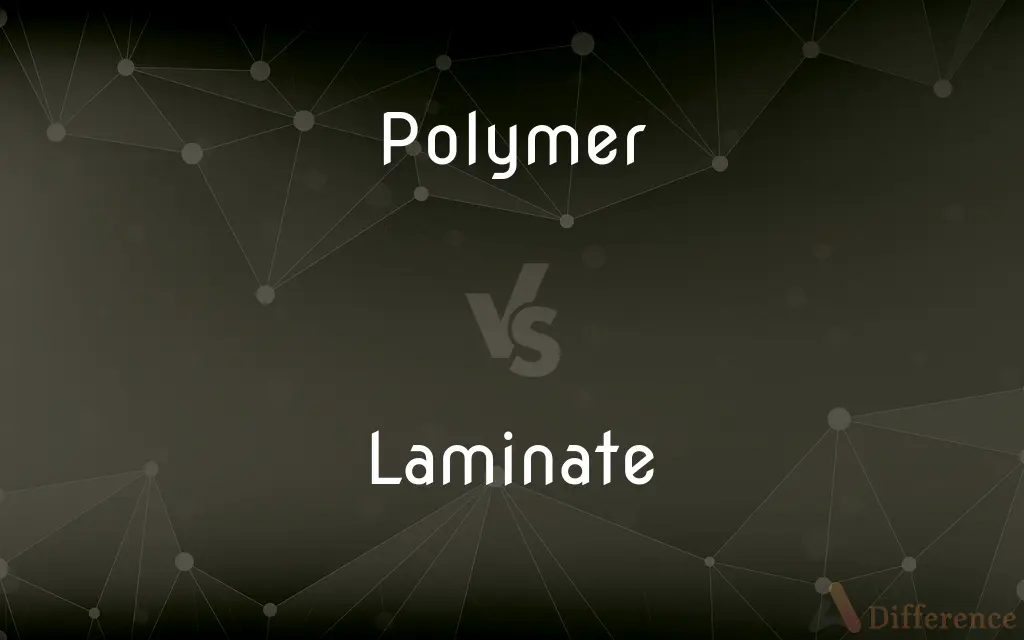Polymer vs. Laminate — What's the Difference?
By Tayyaba Rehman & Fiza Rafique — Updated on March 25, 2024
Polymer is a substance composed of large molecules made from many repeated subunits, while laminate is a material made by bonding two or more layers of the same or different materials.

Difference Between Polymer and Laminate
Table of Contents
ADVERTISEMENT
Key Differences
Polymer refers to a broad class of natural or synthetic materials made up of long, repeating chains of molecules, known as monomers. These materials exhibit a wide range of properties and are used in numerous applications, from plastics and fibers to rubber and adhesives. On the other hand, laminate involves the process of creating a composite material by bonding together multiple layers, which can be of the same material or different materials, to enhance strength, durability, or other desired properties.
Polymers can be either thermoplastic or thermosetting, where thermoplastics can be melted and reshaped multiple times, and thermosets harden permanently after being heated. Laminates, however, are designed to combine the best attributes of their constituent layers, such as increased strength, resistance to moisture, or aesthetic appeal, and are not typically characterized by their ability to be reshaped after initial formation.
The creation of polymers involves chemical reactions that link monomers into long chains or networks, which can be controlled to produce materials with specific characteristics, such as flexibility, toughness, or resistance to heat. Laminates are produced by physically joining layers through various bonding techniques, including the use of adhesives, heat, or pressure, without necessarily inducing chemical changes in the individual layers.
In terms of application, polymers are found in a vast array of products, from everyday household items to high-performance engineering materials. Laminates are often used in construction, furniture, flooring, and electronics, where they provide additional strength, durability, or specific surface properties, such as scratch resistance or decorative patterns.
While polymers can exist as stand-alone materials with their own set of properties, laminates require the combination of multiple layers to achieve their intended performance characteristics. This distinction highlights the fundamental difference in how the two materials are produced and utilized, with polymers offering versatility in their inherent properties and laminates providing tailored solutions through the combination of different materials.
ADVERTISEMENT
Comparison Chart
Composition
Long chains of repeated subunits (monomers)
Multiple layers of the same or different materials
Types
Thermoplastics, thermosets
Wood laminate, plastic laminate, etc.
Production Process
Chemical reactions linking monomers
Bonding layers through adhesives, heat, or pressure
Key Properties
Flexibility, toughness, heat resistance
Strength, durability, moisture resistance
Applications
Plastics, fibers, rubber, adhesives
Construction, furniture, flooring, electronics
Reshaping Ability
Thermoplastics can be reshaped; thermosets cannot
Generally not reshaped after formation
Focus
Versatility in inherent properties
Tailored solutions through combination of materials
Compare with Definitions
Polymer
A substance made from large molecules composed of many repeated subunits.
Nylon, a type of polymer, is widely used in the textile industry for its durability and elasticity.
Laminate
Common in construction, furniture, and decorative applications.
Laminate panels are frequently used in exterior cladding for their strength and resistance to weather conditions.
Polymer
Forms the basis of many materials in modern life.
Polystyrene is a polymer used in insulation, packaging, and disposable tableware.
Laminate
Created by applying heat and/or pressure, sometimes with adhesives.
The manufacturing of plywood, a type of wood laminate, involves bonding layers of wood veneer under high pressure and temperature.
Polymer
Can be designed to exhibit a wide range of physical properties.
Polyethylene, a common polymer, is prized for its toughness and is used in everything from plastic bags to bulletproof vests.
Laminate
A composite material made by bonding two or more layers together.
Laminate flooring combines layers of synthetic and natural materials for durability and aesthetic appeal.
Polymer
Includes both naturally occurring and synthetic materials.
Rubber is a natural polymer with elastic properties, essential for making tires and gaskets.
Laminate
Engineered to enhance specific properties such as strength, durability, or moisture resistance.
Decorative laminates are used in furniture and cabinetry for their wear resistance and variety of designs.
Polymer
Involves polymerization, a chemical process linking monomers.
The production of polyvinyl chloride (PVC) involves polymerizing vinyl chloride monomers, resulting in a versatile polymer used in piping, clothing, and furniture.
Laminate
Can include a variety of materials such as wood, plastic, and metal.
High-pressure laminates are often used in countertops and are known for their resistance to stains and impacts.
Polymer
A polymer (; Greek poly-, "many" + -mer, "part") is a substance or material consisting of very large molecules, or macromolecules, composed of many repeating subunits. Due to their broad spectrum of properties, both synthetic and natural polymers play essential and ubiquitous roles in everyday life.
Polymer
Any of numerous natural and synthetic compounds of usually high molecular weight consisting of up to millions of repeated linked units, each a relatively light and simple molecule.
Polymer
(organic chemistry) A long or larger molecule consisting of a chain or network of many repeating units, formed by chemically bonding together many identical or similar small molecules called monomers. A polymer is formed by polymerization, the joining of many monomer molecules.
Polymer
A material consisting of such polymer molecules.
Polymer
Any one of two or more substances related to each other by polymerism; specifically, a substance produced from another substance by chemical polymerization.
Polymer
A naturally occurring or synthetic compound consisting of large molecules made up of a linked series of repeated simple monomers
Common Curiosities
What makes a material a thermoplastic polymer?
A thermoplastic polymer can be melted and reshaped multiple times without altering its fundamental chemical structure.
Why are laminates used in furniture?
Laminates are used in furniture for their durability, ease of maintenance, and ability to replicate the appearance of natural materials.
How does laminate differ from a single material?
Laminate is a composite made by bonding multiple layers to achieve specific properties, unlike a single material which has its intrinsic properties.
Can laminates include polymers?
Yes, laminates can include polymers among their layers to utilize properties like flexibility, durability, or moisture resistance.
Can laminates be recycled?
Recycling laminates can be challenging due to the difficulty of separating the bonded materials, but some types can be recycled or repurposed.
What is a polymer?
A polymer is a large molecule composed of many repeated subunits, used in a wide range of materials and products.
How are polymers tailored for specific uses?
Polymers are tailored through the polymerization process, where the choice of monomers and the conditions of the reaction can alter the material's properties.
What advantage do laminates have over natural materials?
Laminates can offer improved durability, resistance to wear and moisture, and consistent patterns or colors that might be difficult to achieve with natural materials.
Are all plastics considered polymers?
Yes, all plastics are polymers, but not all polymers are plastics. Plastics are a type of synthetic polymer.
How does the bonding process affect laminate properties?
The bonding process can enhance properties such as strength, thermal insulation, and resistance to chemicals, depending on the materials used and the method of bonding.
What role do polymers play in sustainability?
Polymers, especially biodegradable ones, can play a significant role in sustainability by reducing reliance on non-renewable resources and improving waste management.
Share Your Discovery

Previous Comparison
Cylindrical vs. Round
Next Comparison
Drag vs. DriftAuthor Spotlight
Written by
Tayyaba RehmanTayyaba Rehman is a distinguished writer, currently serving as a primary contributor to askdifference.com. As a researcher in semantics and etymology, Tayyaba's passion for the complexity of languages and their distinctions has found a perfect home on the platform. Tayyaba delves into the intricacies of language, distinguishing between commonly confused words and phrases, thereby providing clarity for readers worldwide.
Co-written by
Fiza RafiqueFiza Rafique is a skilled content writer at AskDifference.com, where she meticulously refines and enhances written pieces. Drawing from her vast editorial expertise, Fiza ensures clarity, accuracy, and precision in every article. Passionate about language, she continually seeks to elevate the quality of content for readers worldwide.














































